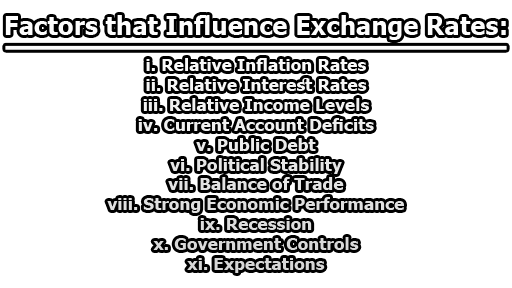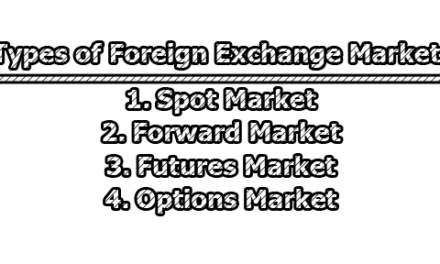The exchange rate between two currencies is the rate at which one currency will be exchanged for another. It is also regarded as the value of one country’s currency in terms of another currency. For example, an interbank exchange rate of 119 Japanese yen (JPY, ¥) to the United States dollar (US$) means that ¥119 will be exchanged for each US$1 or that US$1 will be exchanged for each ¥119. In this case, it is said that the price of a dollar in terms of the yen is ¥119, or equivalently that the price of a yen in terms of dollars is $1/119. In this article, we highlight some factors that influence exchange rates.
Factors that Influence Exchange Rates:
The equilibrium exchange rate will change over time as supply and demand schedules change. A variety of factors can influence currency pricing, and that in turn affects currency exchange rates. The following factors influence exchange rates:
i. Relative Inflation Rates: A relatively higher inflation rate in the UK compared to other countries will tend to reduce the value of the pound because:
- High inflation in the UK means that UK goods increase in price more quicker than European goods.
- Therefore UK goods become less competitive.
- Demand for UK exports will fall.
- Therefore there will be less demand for Pound Sterling.
- Also, UK consumers will find it more attractive to buy European imports.
- Therefore they will supply pounds to be able to buy Euros and Euro imports.
- This increase in the supply of pounds decreases the value of the Pound Sterling.
- Therefore, in the long run, changes in relative inflation rates should lead to a change in exchange rates.
ii. Relative Interest Rates: If UK interest rates rise relative to elsewhere, it will become more attractive to deposit money in the UK. You will get a better rate of return from saving in UK banks, therefore demand for the Sterling will rise. This is known as “hot money flows” and is an important short-run factor in determining the value of a currency. Higher interest rates cause an appreciation.
iii. Relative Income Levels: Assume that the U.S. income level rises substantially while the British income level remains unchanged. Consider the impact of this scenario on (1) the demand schedule for pounds, (2) the supply schedule of pounds for sale, and (3) the equilibrium exchange rate.
First, the demand schedule for pounds will shift outward, reflecting the increase in U.S. income and therefore increased demand for British goods. Second, the supply schedule of pounds for sale is not expected to change. Therefore, the equilibrium exchange rate of the pound is expected to rise.
iv. Current Account Deficits: The balance of trade between a country and its trading partners, which includes all payments for goods, services, interest, and dividends, is known as the current account. A negative current account balance indicates that a nation borrows money from abroad to cover the deficit, indicating that it spends more on international trade than it brings in. In other words, the nation needs more foreign currency than it generates through export sales, and it produces more of it than foreigners are willing to pay for it. As local goods and services become affordable enough for foreign customers and foreign assets become too expensive to produce revenue for domestic interests, the country’s exchange rate declines as a result of the excessive demand for foreign money.
v. Public Debt: The majority of nations rely heavily on financing their deficits to fund their budgets. In other words, they take on debt to fund economic expansion. A currency might lose value if inflation rises and foreign investment is discouraged as a result of the government debt exceeding economic growth. A government may occasionally print money to finance debt, which has the additional effect of raising inflation.
vi. Political Stability: More international investment is attracted to a politically stable nation, which supports the currency rate. Poor political stability has the opposite effect, depreciating a nation’s currency. Local economic and financial policies, which can have a long-term impact on a currency’s exchange rate, are also influenced by political stability. Switzerland and other nations with superior political stability tend to have stronger and more valuable currencies.
vii. Balance of Trade: The relative difference between a country’s imports and exports is known as the balance of trade, sometimes known as terms of trade. For instance, if a nation has a positive trade balance, it signifies that its exports are more than its imports. In this scenario, there is a greater influx of foreign cash than an outflow. A country’s foreign exchange reserves increase as a result, which enables it to reduce interest rates, spur economic expansion, and support the local currency exchange rate.
viii. Strong Economic Performance: Foreign investors invariably look for stable nations with healthy economies to place their money in. A nation with such favorable characteristics will entice capital away from others thought to carry greater political and economic risk. For example, political chaos can result in a decline in the value of a currency and a capital movement to currencies in more stable nations.
ix. Recession: In a recession, a nation’s interest rates are likely to drop, making it harder for it to attract foreign investment. As a result, the value of its currency drops when compared to those of other nations, which lowers the exchange rate.
x. Government Controls: The governments of foreign countries can influence the equilibrium exchange rate in many ways,
- imposing foreign exchange barriers,
- imposing foreign trade barriers,
- intervening (buying and selling currencies) in the foreign exchange markets, and
- affecting macro variables such as inflation, interest rates, and income levels.
xi. Expectations: Like other financial markets, foreign exchange markets react to any news that may have a future effect. News of a potential increase in U.S. inflation may cause currency traders to sell dollars, anticipating a future decline in the dollar’s value. This response places immediate downward pressure on the dollar. Institutional investors take currency positions based on anticipated interest rate movements in various countries.
At the end of the day, we can say that exchange rates indicate the rate at which one currency can be converted into another, or in simpler terms, they indicate how much a specific currency is worth in a foreign currency. Exchange rates play a dynamic role for governments and large financial institutions as well as for investors and forex traders.

Library Lecturer at Nurul Amin Degree College










